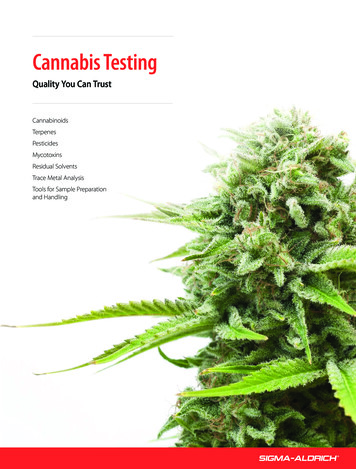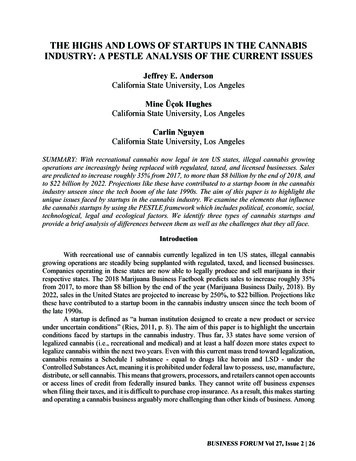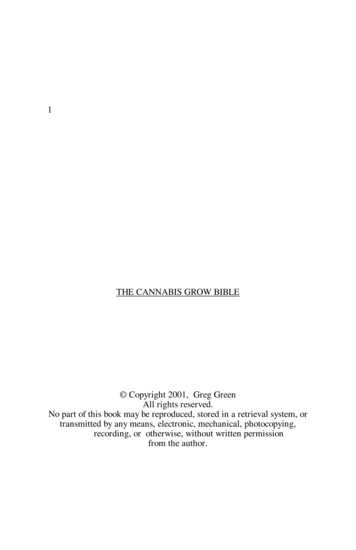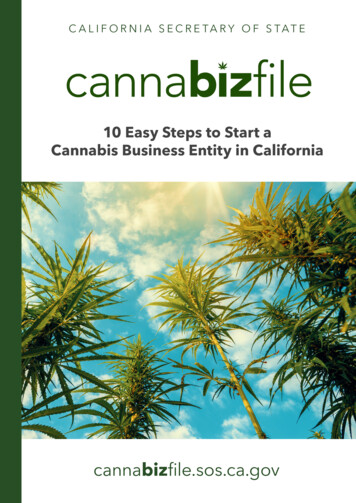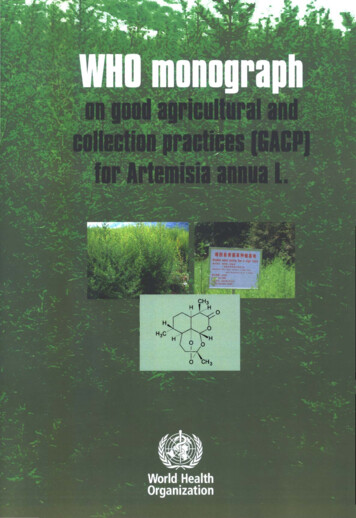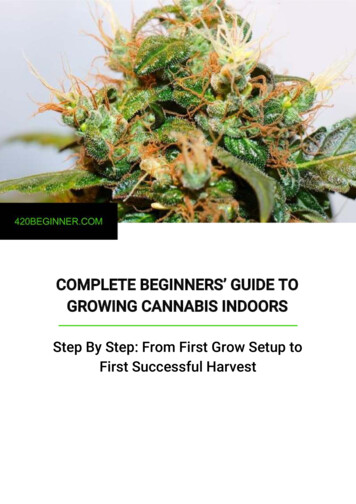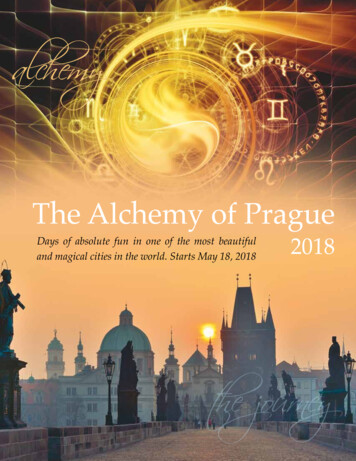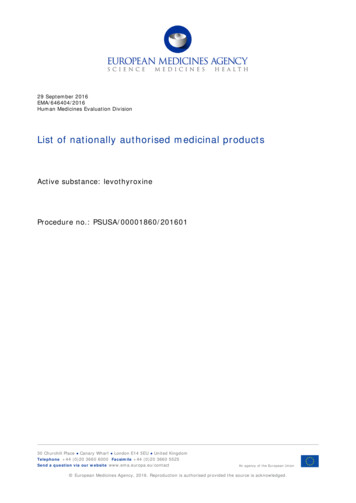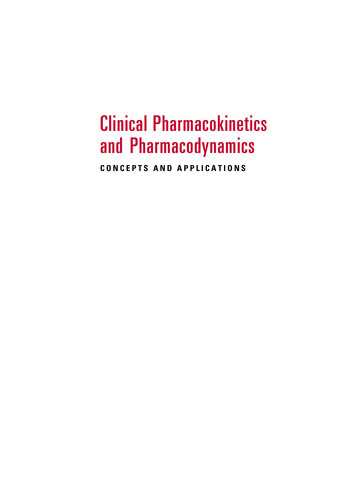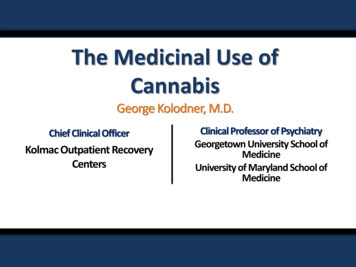
Transcription
The Medicinal Use ofCannabisGeorge Kolodner, M.D.Chief Clinical OfficerKolmac Outpatient RecoveryCentersClinical Professor of PsychiatryGeorgetown University School ofMedicineUniversity of Maryland School ofMedicine
Cannabis is probably the most satisfactory remedyfor the treatment of migraineheadaches.-- Dr. William Osler. Textbook ofMedicine, 1892 - 1915
Marijuana has a high potential for abuse and noaccepted medical value.-- Controlled Substance Act,1970 - 2017
Outline1.2.3.4.5.TerminologyBiologyMedicinal UsePreparationsLegal and Administrative
Categories of CannabinoidsPhytocannabinoids Cannabis sativa plant: 104cannabinoids; 545 totalcompoundsEndocannabinoids 4 cannabinoids in human body(endogenous ligands)Syntheticcannabinoids Multiple chemically synthesizedcannabinoids: pharmaceuticaland recreational
Cannabis Sativa Plant: NamesHemp Refers to the plant and its products Oldest termMarijuana Refers to both plant and drug Relatively new slang termCannabis Refers to both plant and drug DSM-5: “most appropriate scientific term”
Cannabis Sativa: A Unique Plant Source of 3 important types of products1. Fiber (fabric, rope)2. Food (seed, oil)3. Psychoactive substances Used for religious rituals, medicine, recreation Controversy about whether Cannabis Indicaexists as a separate subspecies
Cannabis Sativa: Ingredients Tetrahydrocannabinol (THC)– Primary, but not only, psychoactive ingredientof plant Cannabidiol (CBD)– No rewarding, euphorigenic effect Counteracts psychoactive effect of THC THC and CBD are inversely proportional incannabis plant– Strains developed based on goal of use
2. BIOLOGY
Modern Timeline 1940. Cannabidiol (CBD) isolated from plant1964. THC isolated from plant1981. CBD anticonvulsant effect demonstrated1985. Synthetic THC approved by FDA1988. CB1 receptor identified1992. Endogenous anandamide (AEA)1993. CB2 receptor identified1995. Endogenous 2-arachidonoyl glycerol
Raphael Mechoulam 86 y.o. Israeli chemist, still professionallyactive Identified THC as the primary psychoactiveingredient in cannabis Discovered the endocannabinoid system “The Scientist”: YouTube documentaryabout his discoveries– https://www.youtube.com/watch?v csbJnBKqwIw
Endocannabinoid System:Helps Regulate Multiple Systems PainImmunityInflammationMovementBone densityTumor surveillanceAppetiteStressMood
Endocannabinoid Receptors CB1– Most common receptor in CNS Responsible for psychoactive effects Absent in brain stem no respiratory depression– Also in peripheral nerves and non-neuronal tissues CB2– Located in macrophages– Involved in immune system and anti-inflammatoryactivity Exact functions unknown due to absence of good probes Both inhibit synaptic transmission Other receptors not as well characterized
Endocannabinoid Ligands Anandamide (AEA)– Partial agonist– CNS: Stress response. Periphery: pain– Metabolized by fatty acid amide hydrolase (FAAH) 2-arachidonoyl gylcerol (2-AG)– Full agonist– Broadly expressed. “Workhorse”– Metabolized by mono-acyl-glycerol (MAGL) Ligand diversification: Both act on CB1 receptorbut act differentially to modulate systems
Cellular Neurobiology Neuromodulator (vs. neurotransmitter)– Synthesized on demand rather than stored– Lipids derived from cell membranes, not proteins Retrograde signaling– Synthesized in post-synaptic cell and released intosynaptic cleft– Binds to pre-synaptic CB1 receptor– Acts on pre-synaptic cell to inhibit release of bothexcitatory and inhibitory neurotransmitters Interacts with opioid system
3. MEDICINAL USE
Efficacy High quality evidence–––––Chemotherapy-induced nausea and vomitingAppetite stimulationChronic pain, neuropathic (especially HIV/AIDS)Spasticity of multiple sclerosis, spinal cord injuryAnticonvulsant (CBD for Dravet Syndrome) Low quality evidence– Anxiety, sleep disorders, PTSD Possible role in addiction treatment– Reduce cannabis withdrawal– CBD counteracts psychoactive effect of THC– CB1 blocker rimonabant withdrawn 2008
Cannabinoids and Pain Analgesic properties extensively documentedand widely accepted in Western medicalpractice in 19th and early 20th Centuries– “Used for pain since beginning of recorded time.”– Prescribed to Queen Victoria for pain– Especially for neuropathic and inflammatory pain Do not induce tolerance Interact with opioid system and may allowreduced doses of opioids– CB1 receptors : 10 x more in CNS than mu-opioidreceptors, especially in pain areas
Cannabinoids and Pain: Review of RCTs(Aggarwal) 38 studies, mostly outside of U.S.Preparations: synthetic, extracted, herbalRoutes: oral, oro-mucosal, smoked, topicalResults: 71% found statistically significantpain relief– Modestly effective– Safe and well tolerated
Cannabinoids and Pain: Review of RCTsIndicationsAdvantages Neuropathic pain Fibromyalgia Rheumatoidarthritis HIV neuropathy No reduction inviral load orCD4 cell count Minimaltolerance No toxicoverdoses or endorgan failure Enhancesanalgesic effectof opioids
Cannabinoids and Pain: Review of RCTsAdverse EffectsContraindications Vast majority are notserious No withdrawals fromstudy versus 33% foropioids Cognitive impairment Intoxication Reduced by coadministration of CBD Addiction andwithdrawal History of Cannabis UseDisorder Use cautiously if historyof psychosis
Safety No overdose deaths– Absence of CB receptors in brainstem Intoxication– Impaired driving Especially if mixed with alcohol– Delayed effect Addictive potential– “Gateway hypothesis” Cognitive deficits resulting from heavy use beforeage 18 Fetal development– Negative effect on cognitive functioning in children Association with psychosis– Causation possible
Percentage of People Addicted After Using ASubstance3530252015105032231715119954
4. PREPARATIONS
Pharmaceutical: Synthetic, Oral Dronabinol (Marinol, Syndros)– Synthetic THC isomer– Schedule III– Indications Anti-emetic for cancer chemotherapy when other medicationshave failed Anorexia from AIDS Nabilone (Cesamet)– Analogue of dronabinol– Schedule II– Indication Anti-emetic for cancer chemotherapy when other medicationshave failed
Pharmaceutical: Plant Extract “Entourage Effect” FDA has approval path for botanical medication Sativex (1:1 ratio of THC/CBD)– Oro-mucosal spray (2.7 mg THC/2.5 mg CBD)– Approved in 28 countries for spasticity from multiplesclerosis, neuropathic pain, cancer pain– U.S.: Phase III clinical trials, fast tracked by FDA in April,2014 Epidiolex (cannabidiol)– Purified liquid extract– Anticonvulsant for Dravet syndrome– Orphan Drug Status from FDA, pre-IND
Development of Parallel noidsFormRaw plant or extractsSynthesized or extracted bygovernment standardsRouteSmoked, oral, topicalOral (capsule or spray)DEA Class Schedule ISchedule II, al” growers and Pharmaceutical companiesdispensariesand pharmacies
Non-Pharmaceutical Preparations Quality and standardization issues– Artisanal vs. scientific– Pesticides, contaminants– New emphasis on “product safety protocols” Maryland has adopted American Herbal ProductsAssociation standards Production is evolving from home grown andco-ops to regulated businesses– Outdoor versus indoor (artificial vs. natural light)
Non-Pharmaceutical Preparations:European Example Whole-flower Varieties with standardized THC/CBD ratios– 22%/ 1%– 14%/ 1%– 7%/9%– 1%/9%
5. LEGAL AND ADMINISTRATIVE
Many Puzzles1. Why was cannabis removed from clinicalmedicine without having the problems ofover-prescription and overdosesexperienced with opioid medications?2. Why is the endocannabinoid system nottaught in medical schools?3. Why is cannabis the most difficult of theSchedule 1 substances to research?
Repetitious Process1. Concern about widespread illegal use anduncertainty about facts2. Appointment of high level governmentcommission or scientific committee Conclusion: “Cannabis is not without dangers, butpenalties for use are disproportionate to the threat” Recommend decriminalization3. Opposition from law enforcement, politicians,some physicians4. Sweeping, confident, disrespectful assertions byextremes on both sides5. Stalemate with minimal or no legal changes
Commissions and Committees 1893-4, UK: Indian Hemp Drugs Commission 1929, U.S.: Panama Canal Zone Military Investigation 1939-44, U.S.: LaGuardia Report. NY Academy of Science 1968, UK: Baroness Wootton 1970, Canada: Le Dain Commission 1970-2, U.S.: Schafer Commission (Nixon) 1999, U.S.: Institute of Medicine
Long History of Medicinal Use 2700 BC. First documented use (China) Used for millennia in India, China, Egypt,Middle East Western medicine: mainstream use in 19thand early 20th Centuries– 1850 to 1942. Listed in U.S. Pharmacopoeia Fluid extracts (not raw plant for inhalation) Manufactured by major pharmaceutical companies– Included in major medical publications William Osler’s textbook and others
De-Medicalization of Cannabis(Harry Anslinger)1937Marijuana Tax Act Allowed medical use but imposedheavy administrative burdens Adopted despite AMA opposition Declared unconstitutional in 19691942Removed from U.S.Pharmacopeia19701961Classified as Schedule 1Substance in Controlled DrugSubstances ActIncluded in UN SingleNarcotics Convention
DEA Schedule I Criteria1. High potential for abuse2. No currently accepted use for treatment inthe United States3. Lack of accepted safety for use undermedical supervision
Context of Classification as Schedule I"Since there is still a considerable void in ourknowledge of the plant and effects of theactive drug contained in it, ourrecommendation is that marijuana beretained within Schedule I at least until thecompletion of certain studies nowunderway to resolve the issue.“Dr. Roger O. EgebergAssistant Secretary of HealthAugust 14, 1970
Simplified Legal Alternatives1. Decriminalize– Treat possession of small amounts as a civiloffence or misdemeanor instead of a felony Manage offenses with fines instead of incarceration– Intent: discourage use, prohibit distribution2. Legalize for recreational use– Regulate and tax like alcohol and tobacco– Intent: eliminate black market, collect taxes– Opens door for commercial marketing3. Legalize for medical use
Current Conflicted Legal Status Federal law: Use is illegal for any purpose Many state laws allow medical orrecreational use The Supremacy Clause of U.S. Constitution:– State laws that actively impede or conflict withfederal law are invalid
Medical Legalization History 1981. First bill introduced in US Congress (AIDS) 1996. California became first state to legalize– System flourished despite Federal raids– Drug czar threatened physicians with loss of DEAlicense if they recommended cannabis 2002. Blocked by 9th Circuit. Supreme Court refused to hearappeal thus allowing ruling to stand 2005. Supreme Court allowed Federalgovernment to intervene on users, growers,enterprises despite state law (Gonzales v. Raich)– Perpetuates gray area
Medical Legalization History (cont.) 2009. DOJ “Ogden Memo”: deprioritize CSAenforcement in states where medical cannabisis well regulated 2014. Rohrbacher-Farr Amendment (US Houseof Rep). Blocks DOJ from intervening– 2015. Court decision ordered DOJ to comply 2015. CARERS Act would eliminate gray zone– 2017. Passage is uncertain 2016. DEA reiterated refusal to reschedule– Will permit growers other than Univ of Mississippi
Summary of 2017 Status Medically legal in 28 states– 14 additional states permit cannabidiol oils Patchwork of state programs – no set ofbest practices Quality of substance from nonpharmaceutical sources is evolving For physicians– Legal gray zone has narrowed but persists Physicians are protected from prosecution or loss ofDEA license– Few clinical guidelines
Resulting Obstacles in U.S. Access– Single source for research grade University of Mississippi farm, contracted by NIDA Low THC concentration of research grade Fall, 2016: DEA willing to allow other sources– 5 levels of approval (more than any other drug) DEA – not FDA – has final authority Organizational issues– No government agency focused on beneficial uses Discourages development of newpharmaceutical products
Medical Cannabis in Maryland Law enacted 2013 and 2014, amended 2015 Regulated by Maryland Medical CannabisCommission– Final regulations issued October, 2015 Process– Physicians must register– Producers and dispensaries must be licensed– Physician writes recommendation for patient Any condition that is severe, for which other medical treatmentshave been ineffective, and if the symptoms “reasonably can beexpected to be relieved” by the medical use of cannabis.– Patient obtains medication from dispensary
Current Status of Maryland Program Patients are not yet being registered 214 physicians registered as of February2017 Growers and processors licenseesannounced August, 2016– Challenges pending Updates and answers to FAQs at:mmcc.maryland.gov
What Are We Learning? Market forces join political forces to obscurescientific issues– Expansion or elimination of qualifying conditions– Importance of pricing to avoid gray market Most recommendations are made by a small subsetof physicians Some de facto recreational use occurs– See increase in heavy use more than general use– No significant increase in use by youth so far Thorny issues remain to be resolved– Impaired driving– Positive urine screens at work
Summary Cannabis has medicinal value– Benefits and risks tend to be exaggerated Influence of law enforcement agencies hasoutweighed health agencies Political considerations have interfered withscientific evaluation and left physicians in adisadvantaged position– Beware of selective use of data to supportparticular positions Barriers to research and pharmaceuticaldevelopment should be lowered
References Handbook of Cannabis, ed. By Roger Pertwee. 2014 Adverse Health Effects of Marijuana Use. Volkow, et. al. NEJM370;23. pp. 2219-27. 2014 Review of Medical Use. JAMA: 313, pp. 2431-32, 2456-73, 2474-83.June 23/30, 2015. Cannabinergic Pain Medicine. S. Aggarwal, Clin J Pain. 29 (2), pp.162-171. 2013 NIH Cannabis Neuroscience Research Summit, March 22-23, 2016– https://videocast.nih.gov/summary.asp?Live 18464&bhcp 1 Policy– Marijuana: A Short History. John Hudak, 2016– .resource.php?resourceID 000881– Harry Anslinger’s Congressional /taxact/anslng1.htm
Thank YouQuestions and Commentsgkolodner@kolmac.com
Marijuana Tax Act Allowed medical use but imposed heavy administrative burdens Adopted despite AMA opposition Declared unconstitutional in 1969 1942 Removed from U.S. Pharmacopeia 1961 Included in UN Single Narcotics Convention 1970 Classified
